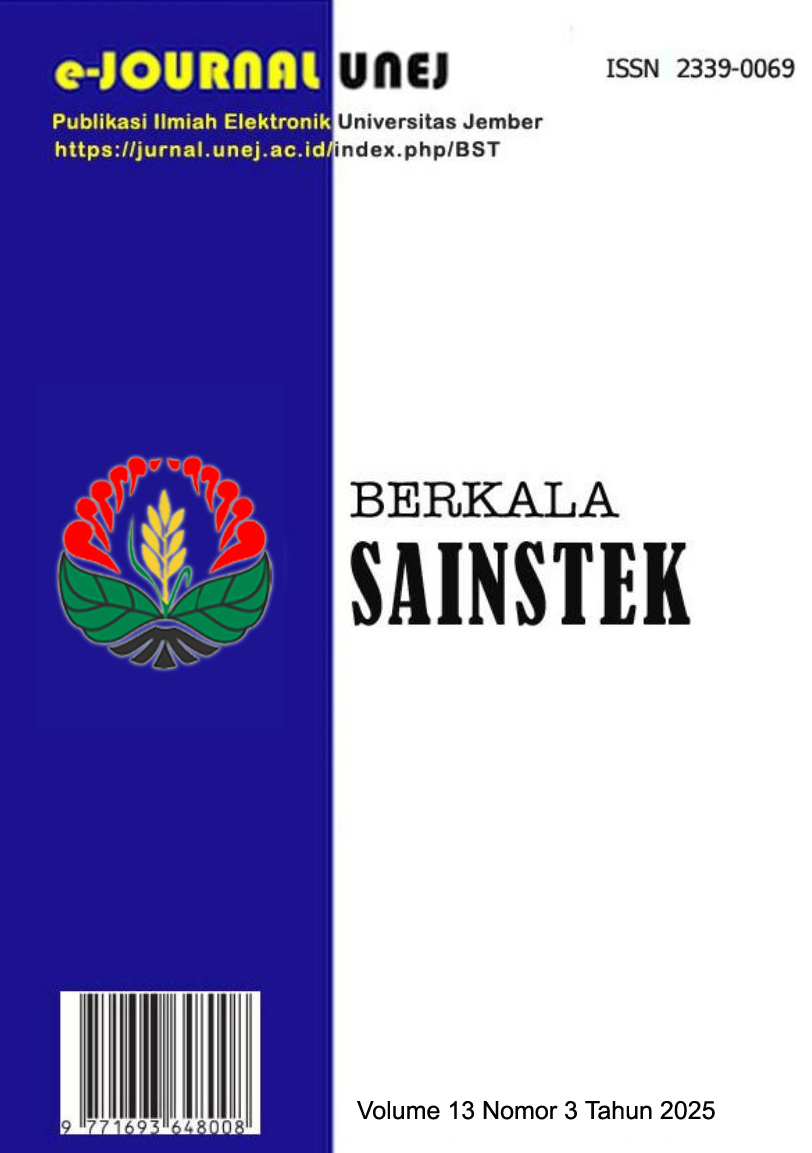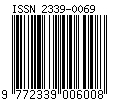Diversity and Density of Seagrass Meadows on Tunda Island
DOI:
https://doi.org/10.19184/bst.v13i3.53525Keywords:
Seagrass, Tunda Island, Density, DiversityAbstract
Tunda Island is an island with many potential resources that can be utilized as a conservation area such as seagrass beds. Seagrass meadows are one type of marine plants that live in shallow waters, have an important role for fish because of the source of food providers and also as a place for fish to shelter from predatory animals. The purpose of this research is to determine the condition of seagrass diversity and density located on Tunda Island, Serang Regency. This research uses provocive sampling method with quantitative approach and analysis using descriptive method. The results of the diversity analysis based on the data obtained are that there are 8 different seagrass species on Tunda Island with a total of 2751 individuals, which include individuals of Thalassia hemprichii, Cymodocea serulata, Halophila ovalis, Cymodocea rotundata, Halophila minor, Halophila spinulosa, Syringodium isoetifolium, and Enhalus acoroides. Seagrass density of each individual shows a difference in each station. At station 1, the seagrass density was 27 ind/m2 with the highest density of 11 ind/m2 by Thalassia hemprichi species, station 2 obtained seagrass density of 44 ind/m2 with the highest seagrass density of 20 ind/m2 by Thalassia hemprichi and Halophila ovalis species. Station 3 obtained seagrass density of 39 ind/m2 with the highest seagrass density of 17 ind/m2 by Thalassia hemprichi species. All research stations are included in the sparse density category due to various factors including environmental pressure and human activities around the research site. Seagrasses that have a high dominant index value have good growth and defense power in the aquatic environment, while seagrasses that have a low diversity index have less resistance in the environment. Because each station has different substrate areas, some are sandy, muddy, and craggy.
Downloads
References
[2] Subagio, "Dominansi Spesies Tumbuhan Lamun di Perairan Pantai Sejuk Kabupaten Lombok Utara," Bioscientist: Jurnal Ilmiah Biologi, vol. 8, no. 2, pp. 346-354, 2020.
[3] K. H. Rombe, D. Rosalina, K. Jamil, A. Surachmat and A. Imran, "Pola Sebaran dan Keanekaragaman Jenis Lamun di Perairan Tanjung Pallete dan Tangkulara Kabupaten Bone
Provinsi Sulawesi Selatan," Jurnal Airaha, vol. 9, no. 2, pp. 164-170, 2020.
[4] Fidayat, F. Lestari and A. H. Nugraha, "Keanekaragaman Spons pada Ekosistem Padang Lamun di Perairan Malang Rapat Kabupaten Bintan," Jurnal Akuatiklestari, vol. 4, no. 2, pp. 71-83, 2021.
[5] Odum, Dasar-Dasar Ekologi (Terjemahan: Tjahyono Samingan), Yogyakarta: Gadjah Mada University Press, 1993.
[6] Z. S. Kamaruddin, S. B. Rondonuwu and P. V. Maabuat, "Keragaman Lamun (Seagrass) di Pesisir Desa Lihunu Pulau Bangka Kecamatan Likupang Kabupaten Minahasa Utara Sulawesi Utara," Jurnal MIPA UNSRAT, vol. 5, no. 1, pp. 20-24, 2016.
[7] I. M. S. Wijana, N. M. Ernawati and M. A. Pratiwi, "Keanekaragaman Lamun dan Makrozoobentos sebagai Indikator Kondidi Perairan Pantai Sindhu Sanur Bali," Ecotrophic: Jurnal Ilmu Lingkungan, vol. 13, no. 2, pp. 238-247, 2019.
[8] M. Sirait, F. Rahmatia and Patulloh, "Komparasi Indeks Keanekaragaman dan Indeks Dominansi Fitoplankton di Sungai Ciliwung Jakarta," Trunojoyo: Jurnal Kelautan, vol. 11, no. 1, pp. 75-79, 2018.
[9] R. A. Siahaya, A. Saimima, R. Yusuf and Rama, "Inventaris dan Kerapatan Jenis Lamun di Perairan Pantai Desa Tanah Rata Kecamatan Banda Kabupaten Maluku Tengah," MUNGGAI: Jurnal Ilmu Perikanan dan Masyarakat Pesisir, vol. 9, no. 1, pp. 39-46, 2023.
[10] B. A. J. Gosari and A. Haris , "Studi Kerapatan dan Penutupan Spesies Lamun di Kepulauan Spermonde," Jurnal Ilmu Kelautan dan Perikanan, vol. 22, no. 3, pp. 156-162, 2012.
[11] M. Yusuf, Y. Koniyo and C. Panigoro, "Keanekaragaman Lamun di Perairan Sekitar Pulau Dudepo Kecamatan Anggrek Kabupaten Gorontalo Utara," NIKE: Jurnal Ilmiah Perikanan dan Kelautan, vol. 1, no. 1, pp. 18-25, 2013.
[12] S. H. Muhammad, A. Djainudin and F. Mahrudin , "Komposisi dan Keanekaragaman Jenis Lamun di Perairan Desa Mandiri Kabupaten Pulau Morotai," Aurelia Journal, vol. 3, no. 1, pp. 73-81, 2021.
[13] A. R. Rappe, "Struktur Komunitas Ikan pada Padang Lamun yang Berbeda di Pulau Barrang Lompo," Jurnal Ilmu dan Teknologi Kelautan Tropis, vol. 2, no. 2, 2010.
Downloads
Published
Issue
Section
License
Copyright (c) 2025 Aldo Barans Putra, Agung Setyo Sasongko, Ferry Dwi Cahyadi

This work is licensed under a Creative Commons Attribution-NonCommercial 4.0 International License.




